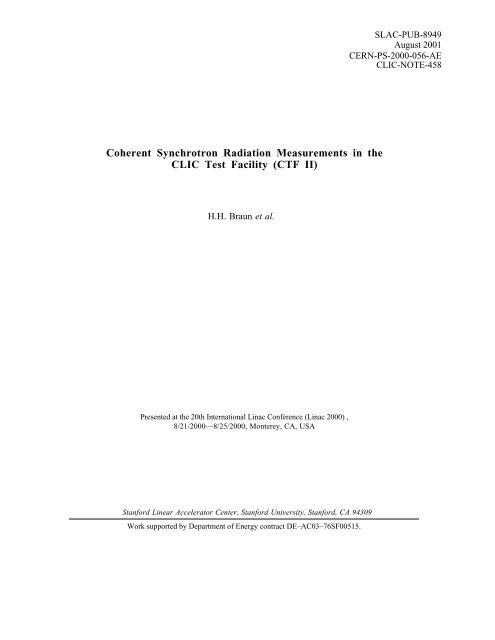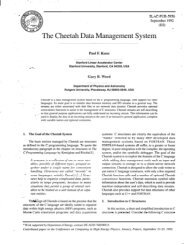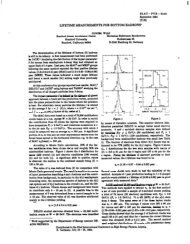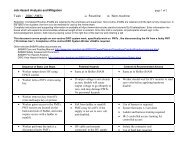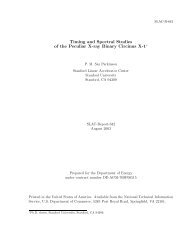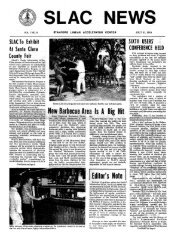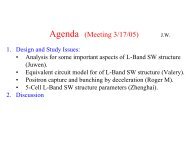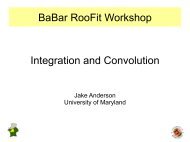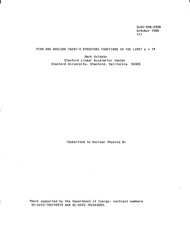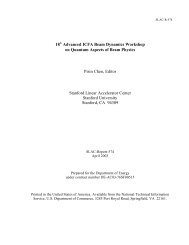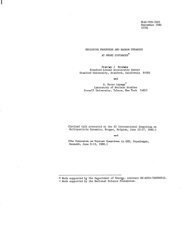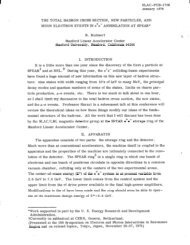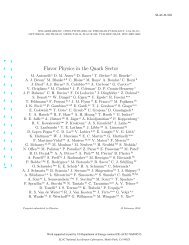slac-pub-8949 - SLAC - Stanford University
slac-pub-8949 - SLAC - Stanford University
slac-pub-8949 - SLAC - Stanford University
Create successful ePaper yourself
Turn your PDF publications into a flip-book with our unique Google optimized e-Paper software.
<strong>SLAC</strong>-PUB-<strong>8949</strong><br />
August 2001<br />
CERN-PS-2000-056-AE<br />
CLIC-NOTE-458<br />
Coherent Synchrotron Radiation Measurements in the<br />
CLIC Test Facility (CTF II)<br />
H.H. Braun et al.<br />
Presented at the 20th International Linac Conference (Linac 2000) ,<br />
8/21/2000—8/25/2000, Monterey, CA, USA<br />
<strong>Stanford</strong> Linear Accelerator Center, <strong>Stanford</strong> <strong>University</strong>, <strong>Stanford</strong>, CA 94309<br />
Work supported by Department of Energy contract DE–AC03–76SF00515.
COHERENT SYNCHROTRON RADIATION MEASUREMENTS IN THE<br />
CLIC TEST FACILITY (CTF II)<br />
H.H. Braun, R. Corsini, L. Groening, F. Zhou, CERN, Geneva, Switzerland<br />
A. Kabel, T. Raubenheimer, <strong>SLAC</strong>, Menlo Park, CA 94025, USA<br />
R. Li, TJNAF, Newport News, VA 23606, USA<br />
T. Limberg, DESY, Hamburg, Germany<br />
Abstract<br />
Bunches of high charge (up to 10 nC) are compressed<br />
in length in the CTF II magnetic chicane to less than<br />
0.2 mm rms. The short bunches radiate coherently in the<br />
chicane magnetic field, and the horizontal and<br />
longitudinal phase space density distributions are<br />
affected. This paper reports the results of beam emittance<br />
and momentum measurements. Horizontal and vertical<br />
emittances and momentum spectra were measured for<br />
different bunch compression factors and bunch charges.<br />
In particular, for 10 nC bunches, the mean beam<br />
momentum decreased by about 5% while the FWHM<br />
momentum spread increased from 5% to 19%. The<br />
experimental results are compared with simulations made<br />
with the code TraFiC 4 .<br />
1 INTRODUCTION<br />
Short electron bunches traversing a dipole with<br />
bending radius U can emit coherent synchrotron radiation<br />
(CSR) at wavelengths longer than the bunch length. The<br />
enhancement of the radiated power, with respect to the<br />
classical synchrotron radiation, can be expressed as [1]:<br />
2<br />
2 c e<br />
' P | 0.028 N<br />
coh<br />
2 4<br />
3 3<br />
H 0 U V Z<br />
where a longitudinal Gaussian distribution of the N<br />
particles with constant rms bunch length V Z<br />
along the<br />
curved trajectory are assumed.<br />
The CSR induces an average momentum loss and a<br />
momentum spread on the bunch. For relativistic beams<br />
the momentum loss is independent of the beam energy<br />
and the effect can be treated like a wake-field. Since it<br />
takes place in a dispersive region, the transverse phase<br />
space distribution is also affected, and the beam emittance<br />
in the bending plane increases.<br />
These effects are a concern in all accelerator<br />
applications in which high-charge short bunches are<br />
needed, e.g., free electron lasers, linear colliders and twobeam<br />
accelerators. Analytical treatments have been<br />
developed for idealised conditions [1-4] but for many<br />
practical cases the effect must be treated numerically.<br />
Some codes have been developed for this purpose [5,6],<br />
but a complete benchmark of the codes with<br />
measurements is so far lacking. The parameters of the<br />
drive beam in the second Compact Linear Collider Test<br />
Facility, CTF II [7] are well suited to study the CSR<br />
effect experimentally.<br />
CTF II (see Fig. 1) was built to demonstrate the<br />
feasibility of two-beam acceleration at 30 GHz. The highcharge<br />
drive beam is generated in a 3 GHz RF gun, and<br />
accelerated in two Travelling Wave Structures (TWS).<br />
The drive beam bunches are then compressed in a<br />
magnetic chicane, and generate 30 GHz RF power in a<br />
series of Power Extraction and Transfer Structures<br />
(PETS). This power is used to accelerate a low-charge<br />
probe beam, in a parallel beam line.<br />
Figure 1: The CLIC Test Facility CTF II. The CSR experiments were performed in the drive beam line (upper part).
Only the drive beam line of CTF II has been used to<br />
perform the CSR experiment. Single bunches with<br />
charges of 5 and 10 nC have been used. For both charges,<br />
the horizontal and vertical beam emittances and the<br />
momentum spectra of the drive beam have been<br />
measured as a function of the deflection angle in the<br />
chicane. Similar measurements have been performed<br />
already in CTF II [8], but limited to the emittances. The<br />
results of simulations made using the code TraFiC 4 [5] are<br />
reported for comparison.<br />
2 EXPERIMENTAL SETUP<br />
Bunch compression is used in CTF II to enhance the 30<br />
GHz power production, and is achieved by acceleration<br />
off-crest (such that particles at the tail of the bunch have<br />
higher energies than those at the head), in combination<br />
with a magnetic chicane composed of three rectangular<br />
dipoles. The deflection angle in the first and the last<br />
dipole can be varied from 3.7q to 14q (twice these values<br />
in the central dipole). The corresponding energy<br />
dependence of the path length R 56<br />
= ds / (dE/E) ranges<br />
from 6 mm to 90 mm. Due to the construction of the<br />
vacuum chamber, the chicane cannot be switched off<br />
completely. Using this scheme, rms bunch lengths of less<br />
than 0.4 mm can by achieved for bunch charges of 10 nC.<br />
The beam momentum spectra were measured at the<br />
entrance to the chicane by switching off the last two<br />
chicane magnets and using the first one as a spectrometer.<br />
A second spectrometer at the end of the line permits the<br />
measurement of the beam spectra after the passage in the<br />
chicane. The PETS were deactivated by shielding them<br />
with metallic tubes, in order not to perturb the momentum<br />
distribution. Two wall-current monitors placed in front of<br />
the chicane and in front of the second spectrometer<br />
measured the beam intensities, in order to monitor the<br />
losses.<br />
The bunch lengths were measured behind the chicane<br />
by analysing the frequency spectrum of the mm-wave<br />
radiation excited by the beam passing an RF waveguide<br />
connected to the vacuum chamber [9]. Transverse beam<br />
profiles were recorded after the chicane using an optical<br />
transition radiation (OTR) screen and a camera. The<br />
horizontal and vertical emittances were measured<br />
simultaneously by using the quadrupole scanning<br />
technique. In order to cover the full range of phase<br />
advances from 0q to 180q in both transverse planes, the<br />
quadrupole strengths of a bipolar triplet were varied<br />
independently. For accurate determination of the beam<br />
widths, only those profiles were selected which fitted on<br />
the OTR screen.<br />
The off-crest RF phase and the range of chicane<br />
settings were selected in order to achieve overcompression<br />
of the initial bunch length, thus covering a<br />
sufficient range in bunch lengths.<br />
3 MOMENTUM SPECTRA AND BUNCH<br />
LENGTH<br />
The beam momentum spectra measured for different<br />
bunch compressor settings are shown in Fig. 2 (5 nC<br />
case) and Fig. 3 (10 nC case). The spectra from TraFiC 4<br />
simulations are also shown. Since the spectrometer at the<br />
end of the beam line consists of a deflecting dipole it also<br />
represents a source of CSR, and the spectra result from<br />
the sum of the CSR effects in the compressor chicane and<br />
in the spectrometer.<br />
dN/dp [arb. units]<br />
8.1 mm<br />
0.69 mm<br />
25 mm<br />
0.29 mm<br />
51 mm<br />
0.13 mm<br />
13 mm<br />
0.46 mm<br />
R 56 = 32 mm<br />
σ bunch = 0.14 mm<br />
62 mm<br />
0.31 mm<br />
40 45 40 45<br />
Momentum [MeV/c]<br />
18 mm<br />
0.36 mm<br />
42 mm<br />
0.13 mm<br />
75 mm<br />
0.46 mm<br />
40 45<br />
Figure 2: Measured (solid line) and calculated (dotted<br />
line) momentum spectra at the end of the beam line for<br />
different compressor settings R 56<br />
, with a bunch charge of<br />
5 nC. The measured bunch lengths are also shown (lower<br />
values).<br />
dN/dp [arb. units]<br />
9.6 mm<br />
0.82 mm<br />
25 mm<br />
0.34 mm<br />
39 mm<br />
0.37 mm<br />
61 mm<br />
0.54 mm<br />
15 mm<br />
0.52 mm<br />
R 56 = 29 mm<br />
σ bunch = 0.36 mm<br />
44 mm<br />
0.48 mm<br />
30 40 30 40<br />
Momentum [MeV/c]<br />
21 mm<br />
0.36 mm<br />
34 mm<br />
0.36 mm<br />
49 mm<br />
0.65 mm<br />
75 mm<br />
0.87 mm Exp CTF II<br />
TraFiC 4<br />
30 40<br />
Figure 3: Measured (solid line) and calculated (dotted<br />
line) momentum spectra at the end of the beam line for<br />
different compressor settings R 56<br />
, with a bunch charge of<br />
10 nC.
p 0<br />
[MeV/c]<br />
∆p rms<br />
[MeV/c]<br />
σ l<br />
[mm]<br />
44<br />
42<br />
40<br />
38<br />
3<br />
2<br />
1<br />
1.5<br />
1<br />
0.5<br />
q bunch<br />
= 5 nC<br />
Exp CTF II<br />
TraFiC 4<br />
q bunch<br />
= 10 nC<br />
Exp CTF II<br />
TraFiC 4<br />
20 40 60<br />
20 40 60<br />
R 56<br />
[mm]<br />
Figure 4: Measured and calculated rms bunch lengths,<br />
mean momenta and momentum spreads as functions of<br />
R 56<br />
, for bunch charges of 5 nC (left) and 10 nC (right).<br />
As the bunches are compressed, the spectrum<br />
broadens, and in the 10 nC case it develops two maxima<br />
beyond maximum compression. During overcompression<br />
the spectrum narrows again.<br />
The measured bunch lengths and the mean momenta<br />
and rms momentum spreads calculated from the<br />
measured spectra are plotted in Fig. 4, as function of R 56<br />
.<br />
They are compared with the results of the TraFiC 4<br />
simulations.<br />
For 5 nC, no significant changes of the mean beam<br />
momentum was observed, although the momentum<br />
spread increased by a factor four at full compression with<br />
respect to the initial spread, and decreased at overcompression.<br />
For charges of 10 nC, a decrease of the<br />
mean momentum by 2 MeV/c, i.e. 5% of the initial beam<br />
momentum, was measured at full compression. The<br />
momentum spread shows a behaviour similar to the one<br />
described for 5 nC. In the 5 nC case the dependence of<br />
the measured bunch length on R 56<br />
shows a symmetric<br />
shape as expected from linear longitudinal dynamics. On<br />
the other hand, the asymmetric shape of the<br />
corresponding curve for 10 nC indicates a strong impact<br />
of CSR on the longitudinal properties for R 56<br />
> 20 mm.<br />
Using the program TraFiC 4 , the bunch, consisting of<br />
500 macro particles, was tracked from the entrance to the<br />
chicane to the end of line spectrometer dipole. At each<br />
step, the sum of fields resulting from magnetic fields,<br />
space charge and CSR wake-fields was applied to the<br />
macro particles. The resulting bunch lengths, emittances<br />
and momentum spectra have been calculated from the<br />
final distributions.<br />
In order to determine the initial conditions to be used in<br />
the simulations, the bunch lengths measured after the<br />
chicane have been used together with the momentum<br />
spectra recorded at the entrance to the chicane. The initial<br />
phase space distributions in the longitudinal plane have<br />
been reconstructed taking into account the contribution to<br />
the intra-bunch momentum correlation of the off-crest RF<br />
phase and of the short-range longitudinal wake-fields in<br />
the accelerating structures. The initial bunch length has<br />
been chosen to fit the momentum spectra at the chicane<br />
entrance and the measured bunch lengths, assuming that<br />
the CSR does not influence the bunch length. As already<br />
mentioned above, this assumption seems to be justified<br />
only for R 56<br />
< 20 mm in the 10 nC case. Indeed, while a<br />
linear longitudinal model describes well the measured<br />
bunch length dependence from R 56<br />
for 5 nC, no set of<br />
initial conditions could be found that can describe the<br />
measured values for 10 nC. Therefore only the bunch<br />
lengths for small R 56<br />
have been used in this case. Since<br />
only a few measurement points are available for the fit,<br />
the input parameters for the 10 nC measurements are<br />
known with less accuracy.<br />
In the case of 5 nC the dependence of the observables<br />
on R 56<br />
was well reproduced. For 10 nC the calculated<br />
bunch lengths agreed with the measured ones until full<br />
compression, but the asymmetric shape of the bunch<br />
length curve was not reproduced, although the TraFiC 4<br />
simulation looks more accurate than the simple linear<br />
calculation. The amount of momentum loss for 10 nC was<br />
calculated correctly, but the experimental and theoretical<br />
curves are shifted with respect to each other, possibly<br />
indicating different initial longitudinal beam parameters<br />
in the experiments and the simulations. Another possible<br />
explanation is a fluctuation in the initial beam parameters<br />
while the measurement was taken. Especially, variations<br />
in RF power and phase could be invoked, since the same<br />
initial conditions have been used to simulate all of the<br />
measurement points and a phase variation of a few<br />
degrees would be enough to explain the discrepancies<br />
found.<br />
On the other hand, a very good matching of the<br />
measured and calculated momentum spreads was found<br />
for both cases. In the case of 5 nC, the simulations reveal<br />
no splitting of the maximum and the shapes of the spectra<br />
show a good agreement. In the 10 nC case, although the<br />
rms widths are in good agreement, the measured and<br />
simulated momentum spectra have somewhat different<br />
shapes. The formation of two maxima occurs in the<br />
simulations for smaller values of R 56<br />
. Since the CSR wake<br />
depends on the exact longitudinal charge distribution<br />
within the bunch, the details of the momentum spectrum<br />
shape should depend on that as well.
p loss<br />
/p o<br />
[%]<br />
∆p rms<br />
/p o<br />
[%]<br />
σ bunch,rms<br />
[mm]<br />
Compressor<br />
4<br />
2<br />
6<br />
4<br />
2<br />
1<br />
0.5<br />
Spectrometer<br />
2 4 6 8 10 12 14<br />
s [m]<br />
Figure 5: Evolution of the bunch length, the rms<br />
momentum spread and the momentum loss (from bottom<br />
to top) along the CTF II beam line as simulated with<br />
TraFiC 4 , for 10 nC. The results with two different setting<br />
of the chicane are shown, corresponding to R 56<br />
= 34 mm<br />
(solid line) and R 56<br />
= 15 mm (dashed line).<br />
In the simulation an initial Gaussian charge distribution<br />
has been assumed, but previous bunch length<br />
measurements with a streak camera indicate a different,<br />
asymmetric charge distribution. The simulations show<br />
that the splitting of the maxima in the spectra for 10 nC is<br />
due to CSR in the chicane, since such a feature is present<br />
in the simulated spectrum right after the chicane.<br />
On the other hand, the broadening of the spectra seems<br />
to be caused by space charge during the drift to the<br />
spectrometer. This is apparent in Fig. 5, where the<br />
evolution of the bunch length, the momentum spread and<br />
the momentum loss along the beam line, simulated with<br />
TraFiC 4 , are shown.<br />
In spite of the fact that some features of the simulated<br />
momentum loss curve are not yet understood, from<br />
Fig. 5, it can be seen that the momentum loss is mainly<br />
concentrated in the chicane region where the bunches are<br />
short, and is a direct indication of CSR emission. On the<br />
other hand, for R 56<br />
= 34 mm, the momentum spread<br />
increases along the whole beam line after the chicane,<br />
showing that such growth is not directly caused by a CSR<br />
effect.<br />
4 EMITTANCES<br />
The measured horizontal and vertical emittances after<br />
the chicane are plotted in Fig. 6 as function of R 56<br />
,<br />
together with the bunch lengths.<br />
The measured vertical emittances for 5 nC are constant<br />
within the error bars, and are consistent with the<br />
simulation results. The measured horizontal emittances<br />
for 5 nC increase until full compression, then a saturation<br />
occurs. The four highest values seem to be shifted with<br />
respect to the lower values. This shift might be due to<br />
dispersion at the location of the OTR screen, caused by a<br />
mismatch of the relative magnetic strength of the chicane<br />
dipoles. It must be noted that these four points were<br />
recorded after switching off the last two magnets of the<br />
chicane in order to check the beam momentum, and then<br />
switching on the magnets again.<br />
For 10 nC the measured vertical emittance shows a<br />
maximum at full compression. This qualitative behaviour<br />
is found also in the simulations. The measured data points<br />
for the horizontal emittance scatter after overcompression,<br />
thus not allowing meaningful conclusions.<br />
The huge growth of the horizontal emittance predicted by<br />
the simulations was not found experimentally. It can be<br />
noted that the increase of the momentum spread also<br />
affects the accuracy of the emittance measurements and<br />
contributes to the error bars and the scattering of the data<br />
points.<br />
γε x<br />
[mm mrad]<br />
γε y<br />
[mm mrad]<br />
σ l<br />
[mm]<br />
300<br />
200<br />
100<br />
300<br />
200<br />
100<br />
1.5<br />
1<br />
0.5<br />
q bunch<br />
= 5 nC<br />
Exp CTF II<br />
TraFiC 4<br />
q bunch<br />
= 10 nC<br />
Exp CTF II<br />
TraFiC 4<br />
20 40 60<br />
20 40 60<br />
R 56<br />
[mm]<br />
Figure 6: Measured and calculated rms bunch lengths and<br />
transverse beam emittances as function of R 56<br />
for bunch<br />
charges of 5 nC (left) and 10 nC (right).
5 CONCLUSIONS AND OUTLOOK<br />
The measurements made in the CTF II drive beam line<br />
showed clear signs of CSR emission. In particular the<br />
momentum loss and bunch length as a function of the<br />
bunch compressor setting in the 10 nC case are well<br />
explained by the CSR effect, such as the two-peak<br />
momentum spectrum shape at 10 nC. A good agreement<br />
was found between measurements and simulations made<br />
with the TraFiC 4<br />
code for all observables, except the<br />
emittance growth for bunches of 10 nC, which is not yet<br />
understood.<br />
Future experiments will aim in particular at an<br />
experimental investigation of the shielding effect of the<br />
beam pipe on the CSR emission. The extension of the<br />
CSR spectrum is limited at the high-frequency end by the<br />
bunch length, and at the low-frequency end by the cut-off<br />
of the beam pipe. When the beam pipe dimensions are<br />
small with respect to the bunch length, CSR emission is<br />
suppressed. While this is indeed the case in many<br />
accelerators, in the CTFII chicane the free space<br />
approximation is valid. It would be interesting to explore<br />
the intermediate regime since often only a partial<br />
shielding can be used to reduce the unwanted CSR effect<br />
in the case of very small bunches. Several approaches to<br />
the calculation of the shielding effect exist [1-4, 10],<br />
using different approximations. The TraFiC 4 code is also<br />
capable of treating the shielding, and could be<br />
benchmarked against the measurements.<br />
Short bunches will be passed through a new fourmagnet<br />
chicane installed downstream of the bunch<br />
compressor. Three vacuum chambers of different height<br />
will be used in order to provide different shielding<br />
environments. The new chicane has been designed for<br />
large deflection angles and small dispersion functions, i.e.<br />
small R 56<br />
. Therefore the bunch length can be made short<br />
and relatively constant in the new chicane, while CSR<br />
emission in this region will be high. A further advantage<br />
will be the smaller disturbance from possible dispersion<br />
errors.<br />
REFERENCES<br />
[1] J.B. Murphy, S. Krinsky, R.L. Gluckstern,<br />
“Longitudinal Wakefield for an Electron Moving on<br />
a Circular Orbit”, BNL-63090, (1996).<br />
[2] L.I. Schiff, “Production of Particle Energies beyond<br />
200 MeV”, Rev. Sci. Instr., 17, 1, 6-14, (1946).<br />
[3] J.S. Nodvick, D.S. Saxon, “Suppression of Coherent<br />
Radiation by Electrons in a Synchrotron”, Phys. Rev.<br />
96, 1, 180-184, (1954).<br />
[4] S.A. Kheifets, B. Zotter, “Coherent Synchrotron<br />
Radiation, Wake Field and Impedance”, CERN SL<br />
95-43 (AP), (1995).<br />
[5] A. Kabel, M. Dohlus, T. Limberg, “Using TraFiC 4 to<br />
Calculate and Minimize Emittance Growth due to<br />
Coherent Synchrotron Radiation”, to be <strong>pub</strong>lished in<br />
Nucl. Inst. and Meth. A.<br />
[6] R. Li, “Self-Consistent Simulation of the CSR<br />
Effect”, Proceedings of the 6 th<br />
European Particle<br />
Accelerators Conference, Stockholm, (1998).<br />
[7] H.H. Braun, “Experimental Results and Technical<br />
Development at CTF II”, Proceedings of the 7 th<br />
European Particle Accelerators Conference, Wien,<br />
June 2000.<br />
[8] H.H. Braun, F. Chautard, R. Corsini, T.O.<br />
Raubenheimer, P. Tenenbaum, “Emittance Growth<br />
During Bunch Compression in the CTF II”, Phys.<br />
Rev. Lett. 84, 658 (2000).<br />
[9] H.H. Braun, C. Martinez, “Non-Intercepting Bunch<br />
Length Monitor for Picosecond Electron Bunches”,<br />
Proceedings of the 6 th European Particle Accelerators<br />
Conference, Stockholm, June 1998.<br />
[10]R. L. Warnock, K. Bane, “Coherent Synchrotron<br />
Radiation and Stability of a Short Bunch in a<br />
Compact Storage Ring”, <strong>SLAC</strong>-PUB-95-6837,<br />
(1995).


